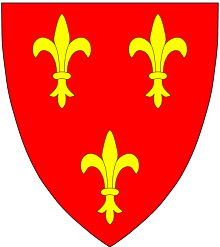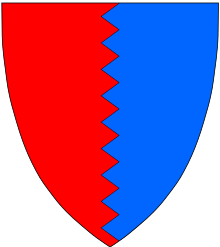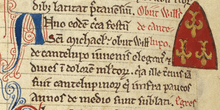William de Cantilupe (died 1254)
William III de Cantilupe (died 25 September 1254) (anciently Cantelow, Cantelou, Canteloupe, Latinised to de Cantilupo) was the 3rd feudal baron of Eaton Bray in Bedfordshire,[3] and jure uxoris (in right of his wife Eva de Braose, heiress of the de Braose dynasty of Welsh Marcher Lords) was feudal baron of Totnes in Devon[4] and Lord of Abergavenny. His chief residences were at Calne in Wiltshire and Aston Cantlow (named after his family), in Warwickshire, until he inherited Abergavenny Castle and the other estates of that lordship.

Origins
He was the eldest son and heir of William II de Cantilupe (d.1251) by his wife Millicent de Gournay (d.1260), a daughter of Hugh de Gournay and widow of Amaury VI of Montfort-Évreux (d. 1213), Earl of Gloucester. His uncle was Walter de Cantilupe (1195-1266), Bishop of Hereford and his younger brother was Thomas de Cantilupe (1220-1282), Bishop of Hereford and Chancellor of England, canonised in 1320.
Marriage and progeny


At some time before 15 February 1248 he married his father's ward Eva de Braose (d.1255), a daughter and co-heiress of William V de Braose (d.1230), "Black William", Lord of Abergavenny, by his wife Eva Marshal, daughter and eventual heiress of William Marshall, 1st Earl of Pembroke. Eva's wardship and marriage had been purchased by his father in 1238. Eva is said to be represented by the surviving recumbent female effigy in the Priory Church of St Mary, Abergavenny (formerly the church of Abergavenny Priory), most of whose body is covered by a large shield sculpted with the arms of Cantilupe ancient (three fleurs-de-lys), and holding a heart in her two hands.[7] By Eva he had the following issue:
- Sir George de Cantilupe (1251-1273), Lord of Abergavenny, only son and heir, who inherited vast estates aged 3 and died in 1273, aged 22, shortly after having reached his majority[8] and recovered his lands from royal wardship. He married Margaret de Lacy but died childless, leaving his sisters or their issue as his co-heiresses.
- Millicent de Cantilupe (d.1299)[9] who married firstly, before 1254[10] (as his second wife) to John de Montalt,[11] who died post 1265[12] without issue. Secondly, at some time before 1273, she married Eudo la Zouche (d.1279), younger son of Roger la Zouche (c.1175-1238) of North Molton in Devon and of Ashby in Leicestershire, and brother of Alan la Zouche (1205–1270), grandfather of Alan la Zouche, 1st Baron la Zouche (1267-1314) "of Ashby", which title was created in 1299. Millicent's moiety of her fraternal inheritance included: the feudal barony of Eaton Bray; the manor of Calne in Wiltshire (her father's seat); a moiety of the feudal barony of Totnes in Devon; the entire feudal barony of Bulwick in Northamptonshire[13] and the manor of Harringworth in Northamptonshire, which her Zouche descendants made their seat, her son William la Zouche, 1st Baron Zouche (1276–1351) being created in 1308 Baron Zouche "of Haryngworth", to distinguish himself from his cousin Alan, made a baron in 1299.
- Joan de Cantilupe (d.1271), who married Henry de Hastings (1225-1268) of Ashill, Norfolk,[14] whose wardship and marriage her father had purchased from Guy de Lusignan in about 1252.[15] Her moiety of her fraternal inheritance included the vast lands of the Lordship of Abergavenny and Aston Cantlow Castle in Warwickshire, one of her father's principal seats.[16] Joan was buried in the Greyfriars, Coventry, Warwickshire, in the Hastings Chapel, together with her husband Henry de Hastings and her son John de Hastings, 1st Baron Hastings, Lord of Abergavenny, all commemorated by effigies (now lost), as related by Dugdale.[17] However Joan de Cantilupe's heart was buried in Abergavenny Priory, and "her effigy there shows her holding a heart in the palm of her hand".[18] The effigy supposedly of Eva de Braose with the Cantilupe shield is also holding a heart, but with both hands.[19] Her sons were:
- John Hastings, 1st Baron Hastings (1262-1313), Lord of Abergavenny, eldest son, who in 1273 inherited a moiety of the lands of his childless uncle Sir George de Cantilupe, including the Lordship of Abergavenny and the Cantilupe seat of Aston Cantlow in Warwickshire. He was summoned to Parliament as Lord Hastings in 1290. His grandson was Lawrence Hastings, 1st Earl of Pembroke, 3rd Baron Hastings (1318–1348).
- Edmund Hastings, 1st Baron Hastings (post 1262-circa 1314) "of Inchmahome" (anciently Inchmacholmok), Perthshire, Scotland, summoned to Parliament on 29 December 1299 as "Lord Hastings". He died at the Battle of Bannockburn in 1314, having married but without issue.[20]
Death

Cantilupe died in 1254,[11] at about Michaelmas, 29 September. His death is recorded by his contemporary Matthew Paris (d.1259) in his Historia Anglorum thus:
- Obiit Will's de Cantelupo; Anno eodem circa festum sancti michaelis obiit Will(ielmus) de Cantelupo juvenis elegans et dives in dolore multorum quia ille tertius iam fuit Cantelupinorum qui infra paucos annos de medio sunt sublati ("W. de Cantilupe died; In the same year (i.e. 1254) around the feast of St Michael died William de Cantilupe, a fine and rich youth, in the grief of many because he was already the third of the Cantilupes who within a few years were lifted up from their midst").
(His father William II had died in 1251 and his grandfather William I in 1239). One of the chief mourners at his funeral was Simon de Montfort, a close friend of the family.[11]
Notes
- Glover's Roll, part 1, B27, William de Canteloupe
- Chronica Maiora - Royal MS 14 C VII, (The Historia Anglorum, or "History of the English", by Matthew Paris (d. 1259), a history of England covering the years 1070-1253. Begun in 1250 and perhaps completed around 1255) arms of William III de Cantilupe, folio 165v
- Sanders, I.J. English Baronies: A Study of their Origin and Descent 1086-1327, Oxford, 1960, p. 40
- Sanders, I.J. English Baronies: A Study of their Origin and Descent 1086-1327, Oxford, 1960, p. 90
- They appear as a marginal drawing of an inverted shield referring to his "impious murder" (Nota impiam murthram). Historia Anglorum, Chronica Majora, Part III; (1250–59) British Library MS Royal 14 C VII f. 116 However Matthew Paris depicts different arms for him in his Chronica Majora, Part III, fol.75v, in an inverted shield: Gules, four piles meeting in base or (Lewis, Susanne, The Art of Matthew Paris in the Chronica Majora)
- See clearer image
- See image
- Age of majority for males was 21
- Sanders, I.J. English Baronies: A Study of their Origin and Descent 1086-1327, Oxford, 1960, p.40
- Sanders, p.40
- Stacey 2004
- Sanders, p.40
- Sanders, p.23
- Kingsford 2004
- Dugdale, William (1605-1686), Antiquities of Warwickshire, 1656, p.616, re manor of Aston Cantlow; M Julian-Jones, Thesis on de Cantilupe and Corbet families, 2015, Online Research @Cardiff (ORCA), Cardiff University, p.83
- Dugdale
- Dugdale, William, Antiquities of Warwickshire, 1666 edition, p.115
- according to Monastic Wales: New Approaches edited by Janet Burton, Karen Stöber
- see better image
- GEC Complete Peerage, vol.VI, p.384
- http://www.bl.uk/manuscripts/Viewer.aspx?ref=royal_ms_14_c_vii_f001v
References
- Calendar of Inquisitions Post Mortem. III. London: HMSO. 1912.
- Kingsford, C.L. (2004). "Hastings, Sir Henry (1235?–1269)". In Ridgeway (ed.). Oxford Dictionary of National Biography. Oxford University Press. Retrieved 26 November 2012.CS1 maint: ref=harv (link)
- Stacey, Robert C. (2004). "Cantilupe, William (III) de (d. 1254)". Oxford Dictionary of National Biography. Oxford University Press. Retrieved 28 November 2012.CS1 maint: ref=harv (link)
Further reading
- Sir Bernard Burke C.B., LL.D., Ulster King of Arms (compiler). (1996). A Genealogical History of the Dormant, Abeyant, Forfeited and Extinct Peerages of the British Empire. Baltimore:: Genealogical Publishing Co, pg. 101.
- Cokayne, G. E. (1912), Gibbs, V. (ed.), The Complete Peerage of England, Scotland, Ireland, Great Britain and the United Kingdom, Extant, Extinct or Dormant, II (new, 13 volumes in 14 (1910–1959) ed.), London: The St. Catherine Press Ltd.
- Frederick Lewis Weis (with additions and corrections by Walter Lee Sheppard, Jr. and assisted by David Faris). (1992). Ancestral Roots of Certain American Colonists Who Came to America before 1700. Baltimore: Genealogical Publishing Co, Line 66.29. Lines: 39-29, 39A-29, 93A-28, 232A-32